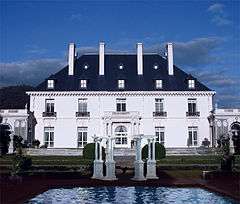National Museum of American Illustration
 | |
| Established | 1998 |
|---|---|
| Location | Newport, Rhode Island, USA |
| Coordinates | 41°28′11″N 71°18′25″W / 41.4696°N 71.3069°W |
| Type | Visual art |
| Director | Laurence S. Cutler and Judy Goffman Cutler |
| Website | http://www.americanillustration.org/ |
The National Museum of American Illustration (NMAI), founded in 1998, is the first national museum to be devoted exclusively to American illustration artwork. The NMAI is located on Newport, Rhode Island's historic Bellevue Avenue in the mansion Vernon Court, designed by the noted Gilded Age architecture firm Carrère and Hastings. The museum's collection contains over 2,000 original works by noted American illustrators such as Norman Rockwell, Maxfield Parrish, J. C. Leyendecker, N.C. Wyeth, and others.[1][2]
History
The NMAI was founded in 1998 by husband and wife team Laurence S. Cutler and Judy Goffman Cutler, with the National Arts Club as its founding institution. The museum opened its doors to the public on July 4, 2000 at the Carrère and Hastings designed Vernon Court estate in Newport, Rhode Island. [3]
In addition to Vernon Court, the adjacent property on Bellevue Avenue, Stoneacre, is owned by the museum. The property is named for the demolished mansion designed by architect William Appleton Potter for John W. Ellis that once occupied the site. The grounds for the site were designed by the noted landscape architect Frederick Law Olmsted, and following the purchase of the site by the NMAI founders, it has been restored as a park in Olmsted’s honor.[4]
The Collection
The NMAI’s American Imagist Collection focuses on artwork from the 'Golden Age of American Illustration', a period whose heyday dates from 1865 to 1945, with the end of the original Saturday Evening Post marking its ultimate demise.[5]
The NMAI features original art created by illustrators such as Norman Rockwell, Maxfield Parrish, N.C. Wyeth, Howard Pyle, J. C. Leyendecker, and Jessie Willcox Smith. The illustrators created images integral to American culture, ranging from the New Year’s Baby to Uncle Sam. For these reasons, the NMAI’s collection has been named the American Imagist Collection.
Notable works by Norman Rockwell in the collection include Russian Schoolroom and The Runaway. The museum’s collection also includes many pieces of art memorabilia and artifacts such as Norman Rockwell's first paint box, Maxfield Parrish’s stippling paint brushes and a plethora of photographic materials.[6]
Vernon Court
The American Imagist Collection is housed in the Carrère and Hastings designed Vernon Court, an adaptation of an 18th-century French chateau (Chateau Haroue), by architect Germain Boffrand.
During the Gilded Age, the U.S. sought symbols of its emerging civilization by appropriating European architectural styles with French style architecture being considered the consummate expression of proper architectural manners. In that atmosphere, Vernon Court was constructed in 1898 by Carrère and Hastings to be used as a summer cottage for a young widow, Anna Van Nest Gambrill (1865–1927). The property remained in the Gambrill family until 1956, when it was auctioned. In 1963, Vernon Court Junior College, a small all girls college, was founded with Vernon Court serving as the school's administrative building until its closing in 1972. Over the next two and a half decades it passed through several different owners. In 1998, Vernon Court was acquired by the Museum founders: Judy Goffman Cutler and Laurence S. Cutler.[7]
The Frederick Law Olmsted Park
Stoneacre (1884), the three acres property opposite Vernon Court, is named for the mansion which once occupied that site. The mansion was designed by architect William A. Potter for John W. Ellis. Potter recommended Frederick Law Olmsted (1822–1903) to Mr. Ellis. Stoneacre was Olmsted's first commission after establishing his office in Brookline and naming the new profession of landscape architecture, making it the first professional landscape architectural commission. The Stoneacre mansion was demolished in 1963, to reduce real estate taxes and the grounds lay dormant for decades thereafter, the last privately owned open space on Bellevue Avenue. Stoneacre was purchased in 1998, by Judy Goffman Cutler and Laurence S. Cutler with a vision to create a memorial park honoring Frederick Law Olmsted, America's first professional landscape architect.[8]
References
- ↑ "Founding of the Museum." NMAI: The National Museum of American Illustration. http://www.americanillustration.org/html/m_founders.html. 27 Oct. 2009.
- ↑ "Museum Mission Statement." NMAI: The National museum of American Illustration. http://www.americanillustration.org/html/m_mission.html.
- ↑ Laurence S Cutler; Judy Goffman Cutler; National Museum of American Illustration. Maxfield Parrish and the American Imagists. Edison, NJ: Wellfleet Press, 2004. pg. 329 - 331.
- ↑ Laurence S Cutler; Judy Goffman Cutler; National Museum of American Illustration. Maxfield Parrish and the American Imagists. Edison, NJ: Wellfleet Press, 2004. pg. 329 - 331.
- ↑ "Artists in the American Imagist Collection." NMAI: The National Museum of American Illustration. http://www.americanillustration.org/html/artists_indexlite07.html. 27 Oct. 2009
- ↑ Berman, Ann E.. "Newport News: An Illustration Museum Debuts in Rhode Island." Architectural Digest, Dec. 1999: 76+. Print.
- ↑ Laurence S Cutler; Judy Goffman Cutler; National Museum of American Illustration. Maxfield Parrish and the American Imagists. Edison, NJ: Wellfleet Press, 2004. pg. 329 - 332.
- ↑ "MuseNews." NMAI: The National Museum of American Illustration. http://www.americanillustration.org/html/news1.html.